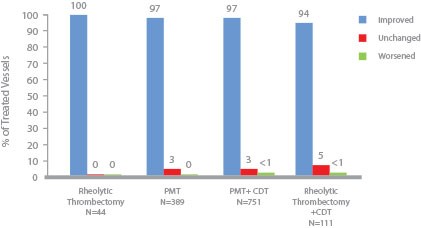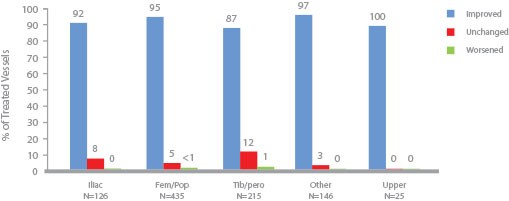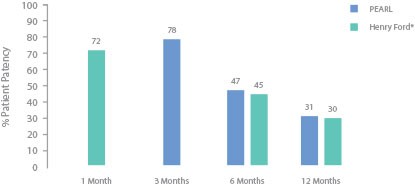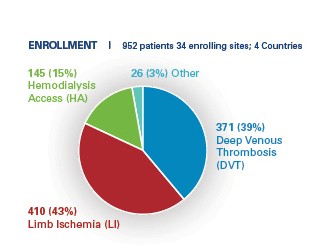AngioJet™
Peripheral Thrombectomy System
Objectives
- Determine efficacy of thrombus removal from baseline to final angiogram/venogram
- Evaluate clinical outcomes of treated patients at defined intervals of 3, 6 & 12 months
- Characterize clinical events
- Characterize treatment options used with the AngioJet System
- Estimate rate of AngioJet Thrombectomy-related adverse events
PEARL DVT N=371 patients
Summary
- 34% of patients treated in single session; 87% of patients had 2 or less lab sessions
- 38% of procedures treated in ≤ 6 hours; 75% completed in ≤ 24 hours
- Less total lytic use when delivered utilizing AngioJet™ (Power Pulse™ and/or Rapid Lysis) than if CDT were included in treatment with final venographic results comparable across all technique subgroups
- 1295 venous vessels treated with 97% showing improvement, 3% unchanged, <1% worse
Venographic results
by Technique Subgroups (p<0.0001) N=1295 vessels treated

CDT, catheter-directed thrombolysis
PMT, pharmacomechanical thrombolysis
Presented by Dr Mark Garcia at CIRSE 2013; Final PEARL Data
- Amongst the 4 treatment groups there wasn’t any statistical difference in baseline occlusion, final occlusion or in the change of occlusion.
- The difference seems to be in the treating physician’s preference to treatment.
PEARL limb ischemia N=410 patients
Summary
- 947 arterial vessels treated with 93% showing improvement, 6% unchanged, <1% worse
- 89% limb salvage rate (185/207). 207 ALI patients had a baseline Rutherford Classification of lla, llb and lll
- 56% of patients treated in single session; 86% of patients had 2 or less lab sessions
- 58% of procedures treated in < 6 hours; 80% completed in < 24 hours
Angiographic results
by location (p<0.0001)

CDT, catheter-directed thrombolysis
PMT, pharmacomechanical thrombolysis
Presented by Dr. Ali Amin at Charing Cross 2014; Final PEARL Data
- Higher % of substantial lysis were achieved in the groups with PMT.
- There was a difference (p=0.0003) In the mean baseline thrombus between the 4 groups. With the PMT + CDT group having a greater occlusion initial score than the other groups.
PEARL AV access N=145 patients
Summary
- Hemodialysis Access Overall Patency: 78% patency at 3 months; KDOQI minimum goal is 40% at 3 months
- 76% graft/fistula survival at 1 year
Treatments utilized & subgroups
- Total 145 patients (65% grafts / 35% fistulas); 186 treated vessels
- 86% (125/145) of patients treated with AngioJet Thrombectomy without thrombolytics
Hemodialysis Access
Overall Patency

*Kakkos SK, Haddad GK, Haddad J, Scully MM. J Endovasc Ther. 2008;15(1):91-102.
Simoni. PEARL Registry Hemodialysis Access. VEITH 2013.
National Kidney Foundation Clinical Practice Guidelines and Recommendations; 2006.
KDOQI, Kidney Disease Outcomes Quality Initiative
Presented by Dr. Eugene Simoni at VEITH 2013; Final PEARL Data
- KDOQI: minimum goal for percutaneous thrombectomy is 40% unassisted patency and functionality at 3 months
